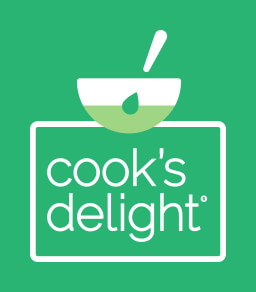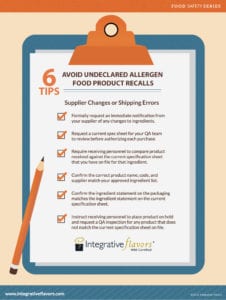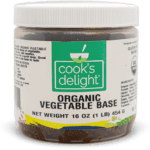Tips to Prevent a Food Recall for Undeclared Allergens
Avoid a Food Recall for Undeclared Allergens
If you spend any time reviewing FDA Recalls, Market Withdrawals and Safety Alerts then you have noticed that a large number of recalls are occurring due to “Undeclared Allergens”.
In a previous blog post we discussed the requirement of having an effective Allergen Control Plan addressing the Big 8 food allergens.
FREE INFOGRAPHIC DOWNLOAD
6 Tips to Avoid Undeclared Allergen Food Recall Educational Poster
Integrative Flavors is pleased to release our Food Safety Series Educational Poster – 6 Tips to Avoid Undeclared Allergen Food Recall to support Food Manufacturing education on allergen management. To continue to receive free resources from Integrative Flavors®, sign up for our newsletter below.
What Causes Recalls for Undeclared Allergens in Foods?
In this blog post we will review the top six scenarios that cause allergen related recalls and discuss specific methods to reduce and eliminate these risks in foods.
Approximately 50% of all food recalls are due to undeclared allergens. This is a very troubling statistic, because all of these issues can be prevented with the development and implementation of an effective allergen control program.
The USDA has evaluated recent allergen-related recalls and has determined that a large number of these recalls are caused by the one of the following scenarios:
- New food ingredients
- New suppliers for food ingredients or products
- Misprinted food label
- Food product in wrong package
- Food product reformulation
- Food ingredient reformulation
Explore our Cook’s Delight® Allergen-Friendly Soup Bases and Flavor Concentrates and learn how our soup bases can help you create better recipes and delight your customers. Learn more about soup base
New Food Ingredients and New Suppliers
Two keys to preventing allergen problems that are caused by the purchase of new food ingredients or new suppliers are: 1) an Approved Supplier Program, and 2) effective communication.
An Approved Supplier Program for Industrial Food Production
When new food ingredients or suppliers must be used, your entire team (e.g., Quality Assurance, Production, Purchasing, Warehousing, and others) must be aware so that they can properly identify and address any potential issues that will arise with the new purchase.
Your Approved Supplier Program should contain a checklist or flowchart that tells you everything that must be checked when a new food ingredient must be purchased. This checklist should contain the following steps (at a minimum):
- Review Specification sheet for the new food ingredient. Compare the ingredient statement, food allergens and other attributes of the new ingredient against the old ingredient.
- Add the ingredient to your Approved Ingredient List.
- Generate a list of your affected Finished Products (if changes are required).
- Create updated ingredient statements for your products.
- Update specification sheets (if applicable.)
- Update labels for all affected products.
- Have all labels reviewed and confirmed for accuracy.
- Remove all OLD and OBSOLETE labels from inventory.
- Notify customers of changes to product (if necessary).
- Notify Production and Receiving personnel of the new ingredient and any allergens that it contains.
- Provide warehousing personnel a copy of the specification sheet for the new ingredient so that they can verify it matches the product that is shipped to your facility.
- Segregate any of the old ingredient that is still in stock from the new ingredient until the old product has been completely used.
Also, when a new supplier must be used, both the ingredient and the supplier must be evaluated to verify that your expectations are being met. One of the things you should request from your new supplier is proof that they have an Allergen Control Plan in place.
Misprinted Food Labels or Foods Product in Wrong Package
These two issues can easily be controlled by an effective Quality Assurance department. One key thing to remember is that it is essential to control your labels at all parts of the process.
You must exercise control on your labels from the time when the label is developed to when it is applied on your finished food product. Old and obsolete labels must be removed from storage and either destroyed or clearly placed on hold so that the labels are not accidentally provided to production personnel.
When labels are needed for production, they should be requested from the staff member who is responsible for controlling your food labels. That person should verify that the labels they are taking out of inventory match the request being made by production. Production personnel must check their production records and confirm that they have the correct label before setting up your labeling machine.
Quality Assurance should perform a “first piece” inspection of product that comes off your line to confirm that the proper label is applied and it is completely legible. Once the product is finished, Quality Assurance should also perform a finished product inspection using a statistical sampling plan. Verifying the correct label is on each container that is sampled is an essential part of the process.
Food Product Reformulation Ingredient Reformulation
These two scenarios are also areas where proper communication among departments is essential.
When your finished food product formulation changes, you must confirm that the ingredient statement either has not changed or that the revised ingredient statement has been updated throughout your system. Your entire team (e.g., Quality Assurance, Production, Purchasing, Warehousing, and others) should meet and discuss the formulation changes so that they are aware. Then they can properly react and address any potential issues that will arise with the formulation change. It is absolutely critical that an assessment of your new formulation is conducted to verify that all food allergens are properly declared on your ingredient statement. Developing a work instruction or a flow chart on how to handle formulation changes would be a very useful tool when formulation changes must take place.
How to Avoid Recalls from Food Product Reformulation Ingredient Reformulation
The key to being prepared when the ingredient formulation on one of your raw materials is changed is making sure that you are aware of the change. Experience has taught me that it isn’t enough to rely on your supplier to notify you that changes have been made to the product. You must be proactive if you want complete confidence in your food product.
The following steps can help you avoid food recall from an undeclared allergen:
- Formally request an immediate notification from your supplier of any changes to ingredients.
- Request a current spec sheet for your QA team to review before authorizing each purchase.
- Require receiving personnel to compare product received against the current specification sheet that you have on file for that ingredient.
- Confirm the correct product name, code and supplier matches your approved ingredient list.
- Confirm the ingredient statement on the packaging matches the ingredient statement on the current specification sheet.
- Instruct receiving personnel to place product on hold and request a QA inspection for any product that does not match the current specification sheet on file.


